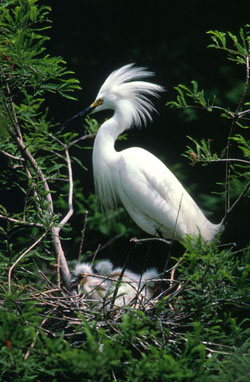

Heron
Snowy Egret, Egretta thula. Note the chicks in the nest.Scientific classification
Kingdom: Animalia Phylum: Chordata Class: Aves Order: Ciconiiformes Family: Ardeidae
Leach, 1820Herons are wading birds in the Ardeidae family. Some are called egrets or bitterns instead of herons. Within the family, all members of the genera Botaurus and Ixobrychus are referred to as bitterns, and—including the Zigzag Heron or Zigzag Bittern—are a monophyletic group within the Ardeidae. However, egrets are not a biologically distinct group from the herons, and tend to be named differently because they are mainly white or have decorative plumes.
The classification of the individual heron/egret species is confusing, because there is still no clear consensus about the correct placement of many species into either of the two major genera, Ardea and Egretta. Similarly, the relationship of the genera in the family is not completely resolved. For example, the Boat-billed Heron is sometimes classed as a heron, and sometimes given its own family Cochlearidae, but nowadays it is usually retained in the Ardeidae.
Although herons resemble birds in some other families, such as the storks, ibises and spoonbills, they differ from these in flying with their necks retracted, not outstretched.
An egret 'iːɡrət/ is any of several herons, most of which are white or buff, and several of which develop fine plumes (usually milky white) during the breeding season. Many egrets are members of the genera Egretta or Ardea which also contain other species named as herons rather than egrets. The distinction between a heron and an egret is rather vague, and depends more on appearance than biology. The word "egret" comes from the French word "aigrette" that means both "silver heron" and "brush," referring to the long filamentous feathers that seem to cascade down an egret's back during the breeding season.
In the 19th and early part of the 20th century, some of the world's egret species were endangered by relentless plume hunting, since hat makers in Europe and the United States demanded large numbers of egret plumes, leading to breeding birds being killed in many places around the world.
The members of this family are all primarily associated with wetlands, and prey on fish, frogs and other aquatic species. Some, like the Cattle Egret or Snow Egret, also take large insects, and are less tied to watery environments. Some members of this group nest colonially in trees, others, notably the bitterns, use reedbeds.
In February 2005, the Canadian scientist Dr. Louis Lefebvre announced a method of measuring avian IQ in terms of their innovation in feeding habits. Herons were named among the most intelligent birds based on this scale, reflecting a wide variety, flexibility and adaptiveness to acquire food[citation needed].
Contents
Taxonomy
Analyses of the skeleton, mainly the skull, suggested that the Ardeidae could be split into a diurnal and a crepuscular/nocturnal group which included the bitterns. From DNA studies and skeletal analyses focusing more on bones of body and limbs, this grouping has been revealed as incorrect (McCracken & Sheldon 1998). Rather, the similarities in skull morphology reflect convergent evolution to cope with the different challenges of daytime and nighttime feeding. Today, it is believed that three major groups can be distinguished (Sheldon et al. 1995, 2000), which are (from the most primitive to the most advanced):
- tiger herons and the boatbill
- bitterns
- day-herons and egrets, and night-herons
The night herons could warrant separation as subfamily Nycticoracinae, as it was traditionally done. However, the position of some genera (e.g. Butorides or Syrigma) is unclear at the moment, and molecular studies have until now suffered from a small number of studied taxa. Especially the relationship among the ardeine subfamily is very badly resolved. The arrangement presented here should be considered provisional.
FAMILY ARDEIDAE
Subfamily Tigrisomatinae
- Genus Cochlearius - Boat-billed Heron
- Genus Tigrisoma
- Bare-throated Tiger Heron, Tigrisoma mexicanum
- Fasciated Tiger Heron, Tigrisoma fasciatum
- Rufescent Tiger Heron, Tigrisoma lineatum
- Genus Tigriornis
- White-crested Tiger Heron, Tigriornis leucolophus
- Genus Zonerodius
- New Guinea Tiger Heron, Zonerodius heliosylus
Subfamily Botaurinae
- Genus Zebrilus
- Zigzag Heron, Zebrilus undulatus
- Genus Ixobrychus - small bitterns (8 living species, 1 recently extinct)
- Genus Botaurus - large bitterns (4 species)
Subfamily Ardeinae
- Genus Zeltornis (fossil)
- Genus Nycticorax (2-4 living species, 5 recently extinct; includes Nyctanassa)
- Genus Gorsachius (3-5 species)
- Genus Butorides (3 species; sometimes included in Ardea)
- Genus Agamia - Agami Heron
- Genus Pilherodius
- Capped Heron, Pilherodius pileatus
- Genus Ardeola (6 species)
- Genus Bubulcus - Cattle Egret (sometimes included in Ardea)
- Genus Proardea (fossil)
- Genus Ardea - typical herons (11-17 species)
- Genus Syrigma
- Whistling Heron, Syrigma sibilatrix
- Genus Egretta - typical egrets (7-13 species)
- Genus undetermined
- Easter Island Heron, Ardeidae gen. et sp. indet. (prehistoric)
Fossil species of unresolved affiliations:
- Xenerodiops (Early Oligocene of Fayyum, Egypt)
- Ardeagradis
- Calcardea
- Proardeola - possibly same as Proardea
Other prehistoric and fossil species are included in the respective genus accounts.
References
- McCracken, Kevin G. & Sheldon, Frederick H. (1998): Molecular and osteological heron phylogenies: sources of incongruence. Auk (journal) 115: 127–141. PDF fulltext
- Sheldon, Frederick H.; McCracken, Kevin G. & Stuebing, Keeley D. (1995): Phylogenetic relationships of the zigzag heron (Zebrilus undulatus) and white-crested bittern (Tigriornis leucolophus) estimated by DNA-DNA hybridization. Auk 112(3): 672-679. PDF fulltext
- Sheldon, Frederick H.; Jones, Clare E. & McCracken, Kevin G. (2000): Relative Patterns and Rates of Evolution in Heron Nuclear and Mitochondrial DNA. Molecular Biology and Evolution 17(3): 437–450. PDF fulltext




